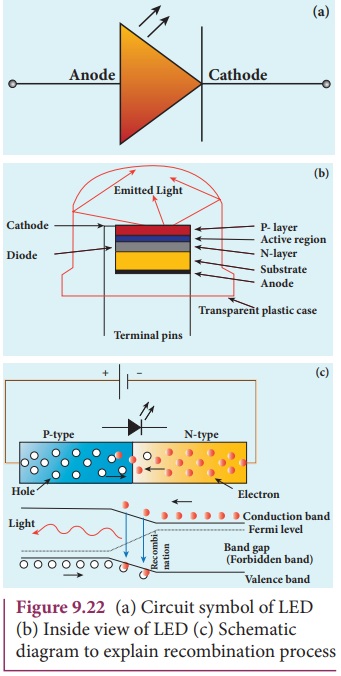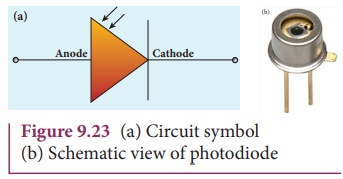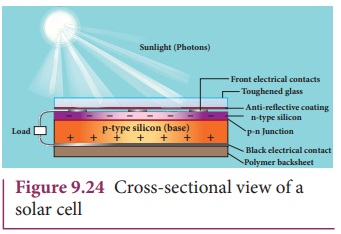Chapter: 12th Physics : UNIT 10a : Semiconductor Electronics
Optoelectronic devices using Diodes
Optoelectronic devices
Optoelectronics deals with devices
which convert electrical energy into light and light into electrical energy
through semiconductors. Optoelectronic device is an electronic device which
utilizes light for useful applications. We will discuss some important
optoelectronic devices namely, light emitting diodes, photo diodes and solar
cells.
1. Light Emitting Diode (LED)
LED is a p-n junction diode which
emits visible or invisible light when it is forward biased. Since, electrical
energy is converted into light energy, this process is also called
electroluminescence. The circuit symbol of LED is shown in Figure 9.22(a).
The cross-sectional view of a
commercial LED is shown in Figure 9.22(b). It consists of a p-layer, n-layer
and a substrate. A transparent window is used to allow light to travel in the
desired direction. An external resistance in series with the biasing source is
required to limit the forward current through the LED. In addition, it has two
leads; anode and cathode.

When the p-n junction is forward
biased, the conduction band electrons on n-side and valence band holes on
p-side diffuse across the junction. When they cross the junction, they become
excess minority carriers (electrons in p-side and holes in n-side). These
excess minority carriers recombine with oppositely charged majority carriers in
the respective regions, i.e. the electrons in the conduction band recombine
with holes in the valence band as shown in the Figure 9.22(c).
During recombination process, energy
is released in the form of light (radiative) or heat (non-radiative). For
radiative recombination, a photon of energy hv
is emitted. For non-radiative recombination, energy is liberated in the
form of heat.
The colour of the light is
determined by the energy band gap of the material. Therefore, LEDs are
available in a wide range of colours such as blue (SiC), green (AlGaP) and red
(GaAsP). Now a days, LED which emits white light (GaInN) is also available.
Applications
ŌĆó Indicator lamps on the front panel of the
scientific and laboratory equipments.
ŌĆó Seven-segment displays.
ŌĆó Traffic signals, emergency vehicle lighting etc.
ŌĆó Remote control of television, airconditioner
etc.
EXAMPLE 9.4
Determine the wavelength of light
emitted from LED which is made up of GaAsP semiconductor whose forbidden energy
gap is 1.875 eV. Mention the colour of the light emitted (Take h = 6.6 ├Ś 10-34 Js).
Solution
Eg = hc / ╬╗
Therefore
╬╗= hc / Eg = 6.6├Ś10ŌłÆ34 ├Ś3├Ś108 / 1.875├Ś1.6├Ś10ŌłÆ19
= 660 nm
The wavelength 660 nm corresponds to
red colour light.
2. Photodiodes
A p-n junction diode which converts
an optical signal into electric signal is known as photodiode. Thus, the operation
of photodiode is exactly inverse to that of an LED. Photo diode works in
reverse bias. Its circuit symbol is shown in Figure 9.23(a). The direction of
arrows indicates that the light is incident on the photo diode.
The device consists of a p-n
junction semiconductor made of photosensitive material kept safely inside a
plastic case as shown in Figure 9.23(b). It has a small transparent window that
allows light to be incident on the p-n junction. Photodiodes can generate
current when the p-n junction is exposed to light and hence are called as light
sensors.

When a photon of sufficient energy (hŽģ) strikes the depletion region of the
diode, some of the valence band electrons are elevated into conduction band, in
turn holes are developed in the valence band. This creates electron-hole pairs.
The amount of electron- hole pairs generated depends on the intensity of light
incident on the p-n junction.
These electrons and holes are swept
across the p-n junction by the electric field created by reverse voltage before
recombination takes place. Thus, holes move towards the n-side and electrons
towards the p-side. When the external circuit is made, the electrons flow
through the external circuit and constitute the photocurrent.
When the incident light is zero,
there exists a reverse current which is negligible. This reverse current in the
absence of any incident light is called dark current and is due to the
thermally generated minority carriers.
Applications
ŌĆó![]() Alarm system
Alarm system
ŌĆó Count items on a conveyer
belt
ŌĆó Photoconductors
ŌĆó Compact disc
players, smoke detectors
ŌĆó Medical
applications such as detectors for computed tomography etc.
3. Solar cell
A solar cell, also known as
photovoltaic cell, converts light energy directly into electricity or electric
potential difference by photovoltaic
effect. It is basically a p-n junction which generates emf when solar
radiation falls on the p-n junction. A solar cell is of two types: p-type and
n-type.
Both types use a combination of
p-type and n-type Silicon which together forms the p-n junction of the solar
cell. The difference is that p-type solar cells use p-type Silicon as the base
with an ultra-thin layer of n-type Silicon as shown in Figure 9.24, while
n-type solar cell uses the opposite combination. The other side of the
p-Silicon is coated with metal which forms the back electrical contact. On top
of the n-type Silicon, metal grid is deposited which acts as the front
electrical contact. The top of the solar cell is coated with anti-reflection
coating and toughened glass.

In a solar cell, electronŌĆōhole pairs
are generated due to the absorption of light near the junction. Then the charge
carriers are separated due to the electric field of the depletion region.
Electrons move towards nŌĆōtype Silicon and holes move towards p-type Silicon
layer. The electrons reaching the n-side are collected by the front contact and
holes reaching p-side are collected by the back electrical contact. Thus a
potential difference is developed across solar cell.When an external load is connected to the solar cell, photocurrent
flows through the load.
Many solar cells are connected
together either in series or in parallel combination to form solar panel or
module. Many solar panels are connected with each other to form solar arrays.
For high power applications, solar panels and solar arrays are used.
Applications:
ŌĆó Solar cells are
widely used in calculators, watches, toys, portable power supplies, etc.
ŌĆó Solar cells are
used in satellites and space applications
ŌĆó Solar panels are used to generate
electricity.
Related Topics